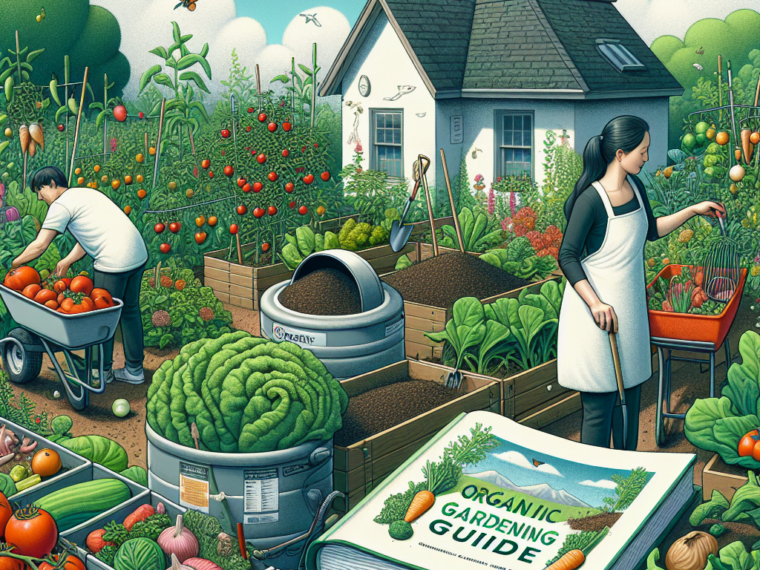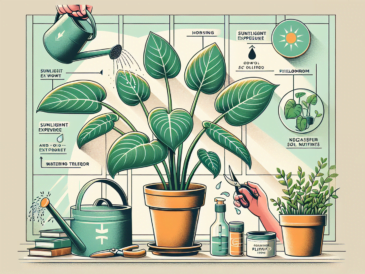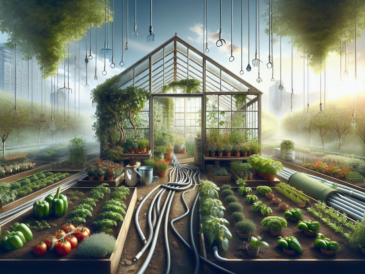Organic gardening means growing plants without chemical pesticides, fertilizers, or herbicides. It’s all about working with nature, using methods that are good for the earth to keep soil healthy and encourage lots of different species. Not only do you get tasty and wholesome food, but you also do less damage to the environment.
Overview of Organic Gardening
In organic gardening, we try to make a balanced garden ecosystem. This includes natural ways to fight off pests and diseases, improve the soil, and help plants grow better. We focus on compost, changing up crops, and planting different plants together to keep the soil full of nutrients and to cut down on chemicals.
Importance of Sustainable and Environmentally-Friendly Practices
Using sustainable and green practices in organic gardening is really important for keeping the soil, water, and air healthy. By staying away from synthetic chemicals, organic gardeners protect helpful insects, birds, and other animals, and they also avoid exposing themselves to bad stuff.
Understanding soil composition and structure
Before starting an organic garden, it’s key to know what your soil is like – its pH, texture, and what nutrients it has. Testing the soil will show what’s in it and point out any missing parts that need to be fixed up.
Techniques for improving soil fertility
To make your soil more fertile organically, you can do a few things like adding natural fertilizers such as compost or animal poo. Also, planting cover crops and moving your crops around helps stop the soil from getting worn out and keeps it rich in good stuff.
Composting and organic matter incorporation
Composting is a big part of organic gardening. You turn kitchen leftovers, yard trash, and other organic materials into something that makes the soil better. Adding this stuff into your soil holds onto water and supports tiny organisms that are super helpful.
Seed Selection and Germination
In organic gardening, picking the right seeds is key for good results. Go for organic, non-GMO seeds first. Then make sure you start them off right with the proper mix and enough water and warmth for them to sprout well.
Transplanting and Direct Seeding
To get plants into your garden, you can transplant — which means moving little plants from their starter home into the garden — or direct seed, putting seeds straight into the garden bed. Either way, you need to prepare the soil well and keep on top of watering and fending off bugs and bad weather.
Crop Rotation and Intercropping
Switching crops each time you plant and mixing different crops together are smart ways to keep your soil happy and steer clear of pests and sicknesses. Crop rotation stops your soil from losing its power, and intercropping uses space wisely while helping with pest control thanks to the variety of plants.
Pest and disease control is super important if you want a thriving organic garden. This means knowing what bugs and diseases are common, using natural ways to deal with them, and keeping your plants healthy to prevent issues.
Identifying common plant pests and diseases
The first step in controlling pests and diseases is being able to spot troublemakers like aphids, caterpillars, mites, mildew, blight, and root rot early on. Spotting these problems allows you to act fast so they don’t get out of hand.
Natural and organic pest control methods
Rather than using chemicals, organic gardeners have other tricks like inviting good bugs that eat the bad ones, spraying with natural stuff like neem oil, or planting certain plants that bugs don’t like. These ways work well without messing up your garden’s balance.
Disease prevention through proper plant care and maintenance
Avoiding plant diseases starts with taking good care of your plants – giving them plenty of light, water, and food. Make sure there’s enough room for air to move around them too. Check on your plants often and get rid of any sick leaves quickly to keep diseases from spreading.
Irrigation – how you water your garden – is another piece of the organic puzzle where using smart techniques can save water.
Efficient Watering Techniques
It’s crucial to water your garden right. Systems that drip or soaker hoses give water straight to plant roots, cutting down on waste. Watering when it’s cooler, like morning or evening, helps too since less water evaporates away.
Mulching for Water Conservation
Mulch acts like a cozy blanket for soil: it holds moisture in, keeps weeds out, and even makes the ground healthier. All this means you don’t need as much water for your plants to grow strong.
Rainwater Harvesting and Irrigation Systems
Catching rainwater for your garden is both free and eco-friendly. A clever drip system set up just right will put every drop where it’s needed most without wasting any.
When it’s time to pick your veggies or fruit, knowing when and how makes sure they’re at their best. Leafy greens should be picked when tender; root veggies when at just the right size.
Proper Handling and Storage
After picking your crops, handle with care! Clean off any dirt gently, then store them somewhere cool and dark with the right dampness level so they stay yummy longer.
Extending the Shelf Life of Fruits and Vegetables
You can keep fruits and veggies fresh longer with a fridge to slow ripening or by preserving them through canning, freezing or drying. That way you can enjoy them for much longer!
Utilizing season extension techniques for year-round gardening
To keep on gardening even when it’s cold outside use tricks like covers or mini-greenhouses over your beds. These tools let you keep growing even through frosty weather!
Greenhouse construction and management
If you have or want a greenhouse, managing it well is golden. It lets you grow stuff all year in a nice controlled spot. Just make sure you’ve got the temperature, wetness levels right inside.
Growing heat-loving plants in cooler climates
In chilly places wanting warm-weather plants like tomatoes or peppers just means creating a cosy space with something like a greenhouse or season extenders to give them the warmth they crave.
You need a sharp marketing plan if you’re planning on selling that organic produce.
Figure out who wants what you’re growing, how to grab their attention, and where it’s best to sell your goods – maybe at farmer markets or straight to shops!
Building Relationships with Local Markets and Consumers
Fostering connections with folks who buy your produce is crucial – talk with them honestly, cater to what they need from you as a vendor and always keep that produce top-notch quality.
Certification and Labeling Requirements for Organic Products
To sell your greens as truly organic you’ll need certificates from official groups. Keep your labels truthful and stay up-to-date with rules about organic foods – this builds trust with customers!
‘.
Frequently Asked Questions (FAQ)
How do you grow the plants?
To grow plants, you need to start with good soil preparation, choose the right seed varieties, and provide the necessary planting conditions such as light, space, and water. It’s also important to consider the planting depth, pH levels, and soil temperature for successful plant growth.
What are the 5 things to make a plant grow?
The five key factors to make a plant grow are soil, seed, light, water, and nutrients. These elements are essential for the germination, growth, and development of plants.
How do you grow a plant in 6 steps?
You can grow a plant in 6 steps by preparing the soil, selecting suitable seed varieties, planting at the right depth, providing adequate light and water, and ensuring proper aftercare for healthy plant growth.
What are the 4 stages of plant growth?
The four stages of plant growth are germination, seedling stage, vegetative growth, and flowering/fruiting stage. Each stage is crucial for the overall development of plants.
What are the 7 stages of a plant?
The seven stages of a plant include seed, germination, seedling, vegetative growth, flowering, fruiting, and seed production. These stages represent the life cycle of a plant from seed to seed production.
What is the 5 step plant life cycle?
The five-step plant life cycle consists of seed, germination, seedling, vegetative growth, and flowering/fruiting stages. This cycle depicts the progression of a plant from seed to the production of flowers or fruits.
What are the 10 stages of plant growth?
The 10 stages of plant growth encompass seed selection, soil preparation, planting, germination, seedling stage, vegetative growth, flowering, fruiting, seed production, and aftercare. Each stage plays a vital role in the complete growth cycle of plants.
What are the 10 stages of plant life cycle?
The 10 stages of plant life cycle include seed selection, soil preparation, planting, germination, seedling stage, vegetative growth, flowering, fruiting, seed production, and aftercare. These stages collectively represent the entire life cycle of a plant.
How long is a plant cycle?
The duration of a plant cycle varies depending on the type of plant and environmental conditions. It can range from a few weeks for annuals to several years for perennials.
Why are the 5 stages of plant growth?
The five stages of plant growth are essential for the successful development of plants. They encompass seed selection, soil preparation, planting, germination, and aftercare, all of which contribute to healthy and robust plant growth.



